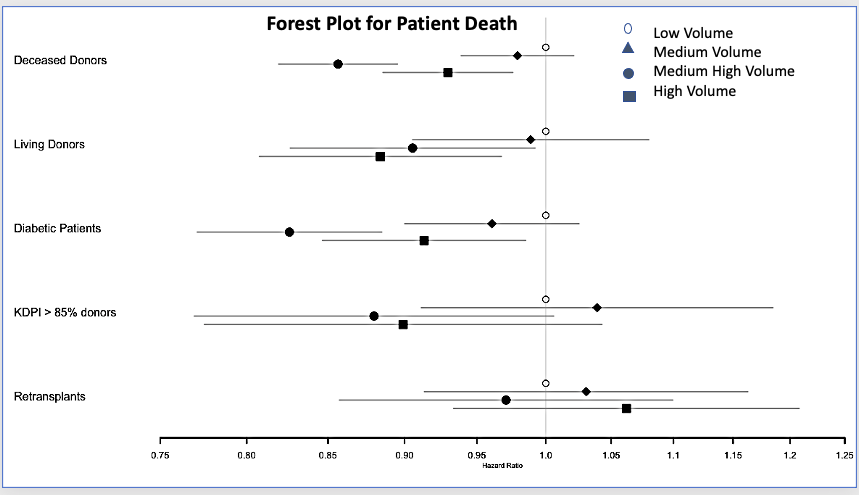Center Volume and Transplant Outcomes in Adult Kidney Transplant Recipients; A Competing Risk Analysis
1Virginia Commonwealth University, Richmond, VA, 2University of Arizona, Tuscon, AZ
Meeting: 2022 American Transplant Congress
Abstract number: 1736
Keywords: Kidney transplantation
Topic: Clinical Science » Kidney » 50 - Health Equity and Access
Session Information
Session Time: 7:00pm-8:00pm
 Presentation Time: 7:00pm-8:00pm
Presentation Time: 7:00pm-8:00pm
Location: Hynes Halls C & D
*Purpose: The precise effect of center volume is a much-debated topic in the field of transplantation. Several studies have shown better post-transplant outcomes in higher volume centers for the majority of solid organ transplants including heart, lung, and liver. However, the concept has been challenged in the setting of adult kidney transplants (KT) by the studies using conventional methods of survival analysis and ignoring the competing risk factors that can preclude the occurrence of events of interest especially in patients with advanced kidney disease.
*Methods: A retrospective cohort study analyzing the data from Organ Procurement Organization Network (OPTN) oversight by Health Resources and Services Administration, US Department of Health and Human Services for kidney transplantation between 2001-2015 was performed. Primary exposure was transplant center volume. The final cohort included 219,878 KT at 256 transplant centers (Table1). The mean annual number of kidney transplants were 2-65, 66-110, 111-195, and 198-315 per year at low (Q1), medium (Q2), medium-high (Q3), and high volume (Q4) transplant centers respectively.
*Results: Differences were observed in the rate of 5-year allograft failure (censored by graft failure or death due to graft failure) and all-cause mortality ( death censored ) across the groups. Unadjusted graft failure was highest in Q4 (26% ) for deceased donor (DD) transplants and in Q1 (15.5%) for living donors (LD) whereas all-cause mortality was highest in Q1 (15.8%) for DD and in Q4 (16.8%) for LD recipients. However adjusted competing risk analysis models showed significantly lower allograft loss ( aHR=0.9296, 95%CI: 0.8856, 0.9757; p-value = 0.0031) and all-cause mortality in Q4 (aHR =0.9220, 95%CI: 0.8785, 0.9677; p-value = 0.0010) as compared to Q1 for DD transplant recipients however the mortality was higher in Q4 (aHR= 1.1639, 95%CI: 1.0887, 1.2442; p-value <0.0001) for LD transplant recipients.Q4 centers performed highest number of LD transplants (48%) as compared to other centers (Q1=34% Q2= 35% Q3=37%)
*Conclusions: Higher center volume is associated with better clinical outcomes in adult DD kidney transplant recipients.
To cite this abstract in AMA style:
Azhar A, Defor E, Kamal L, Bandyopadhyay D, Tanriover B, Gupta G. Center Volume and Transplant Outcomes in Adult Kidney Transplant Recipients; A Competing Risk Analysis [abstract]. Am J Transplant. 2022; 22 (suppl 3). https://atcmeetingabstracts.com/abstract/center-volume-and-transplant-outcomes-in-adult-kidney-transplant-recipients-a-competing-risk-analysis/. Accessed December 28, 2025.« Back to 2022 American Transplant Congress


